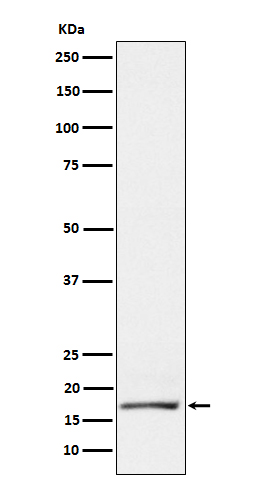
| WB | 咨询技术 | Human,Mouse,Rat |
| IF | 1/20-1/50 | Human,Mouse,Rat |
| IHC | 咨询技术 | Human,Mouse,Rat |
| ICC | 1/50-1/200 | Human,Mouse,Rat |
| FCM | 咨询技术 | Human,Mouse,Rat |
| Elisa | 咨询技术 | Human,Mouse,Rat |
| Aliases | BRST2; GCDGP15; gp17; GPIP4; PIP; Prolactin induced protein; SABP; Secretory actin binding protein;;GCDFP 15 |
| WB Predicted band size | 17 kDa |
| Host/Isotype | Rabbit IgG |
| Antibody Type | Primary antibody |
| Storage | Store at 4°C short term. Aliquot and store at -20°C long term. Avoid freeze/thaw cycles. |
| Species Reactivity | Human |
| Immunogen | A synthesized peptide derived from human GCDFP 15 |
| Formulation | Purified antibody in PBS with 0.05% sodium azide,0.05% BSA and 50% glycerol. |
+ +
以下是关于GCDFP15抗体的3篇参考文献摘要:
---
1. **文献名称**: *"GCDFP-15 as a specific marker for breast and salivary gland carcinoma in cytology"*
**作者**: Bhargava R, Beriwal S, Dabbs DJ
**摘要**: 该研究评估GCDFP15抗体在细胞学标本中诊断乳腺癌和唾液腺癌的应用,证实其高特异性(尤其在区分乳腺与其他来源转移癌中的作用),但敏感性受肿瘤异质性限制。
2. **文献名称**: *"Comparison of GATA3 and GCDFP15 expression in triple-negative breast carcinomas"*
**作者**: Cimino-Mathews A, Subhawong AP, Illei PB
**摘要**: 研究比较GATA3与GCDFP15在三阴性乳腺癌中的表达,发现GATA3敏感性更高(60% vs. 23%),而GCDFP15特异性更强,建议联合使用以提高诊断准确性。
3. **文献名称**: *"Utility of GCDFP15 immunohistochemistry in identifying primary sites of metastatic carcinoma"*
**作者**: Lewis GH, Subhawong AP, Nassar H
**摘要**: 分析GCDFP15在转移性癌中的诊断价值,发现其对乳腺和汗腺来源的肿瘤高度特异,但在低分化癌中表达率低,需结合其他标记物(如ER、HER2)综合判断。
---
这些研究均强调GCDFP15抗体的高特异性,但提示其敏感性有限,需与其他标记物联合使用以提高诊断效能。
GCDFP15 (Gross Cystic Disease Fluid Protein 15), also known as BRST-2 or prolactin-inducible protein (PIP), is a 15 kDa glycoprotein primarily expressed in apocrine secretory cells of the breast, salivary glands, sweat glands, and prostate. It functions in lubrication, immune modulation, and steroid hormone binding. As a tumor marker, GCDFP15 is highly specific for mammary origin, making it a valuable target in diagnostic pathology. The GCDFP15 antibody is a monoclonal or polyclonal reagent used to detect this protein in tissue samples via immunohistochemistry (IHC).
In clinical practice, GCDFP15 antibody aids in identifying primary or metastatic breast carcinomas, particularly hormone receptor-positive and HER2-negative subtypes. It helps differentiate breast cancer metastases from other adenocarcinomas (e.g., lung, ovarian) and confirms apocrine differentiation in breast lesions. While its sensitivity is moderate (~50–70% in breast cancers), its high specificity (>90%) complements other markers like GATA3. Limitations include reduced expression in triple-negative or high-grade tumors and occasional cross-reactivity with salivary or skin adnexal tissues. Recent studies also explore its role in prognostication and therapy response. Overall, GCDFP15 antibody remains a cornerstone in diagnostic algorithms for tumors of uncertain origin.
×